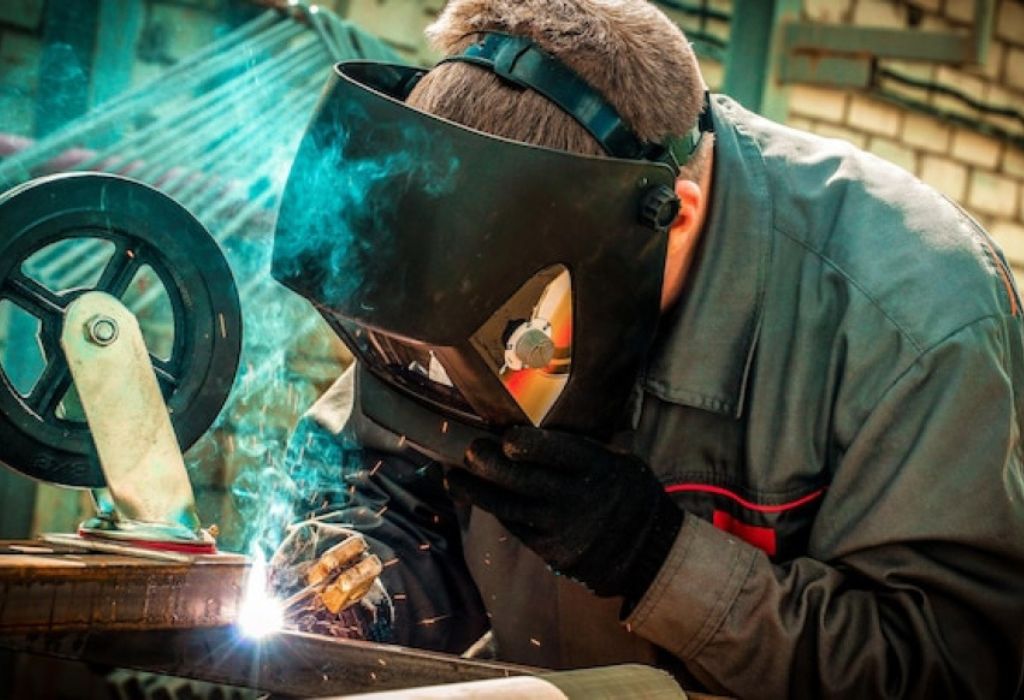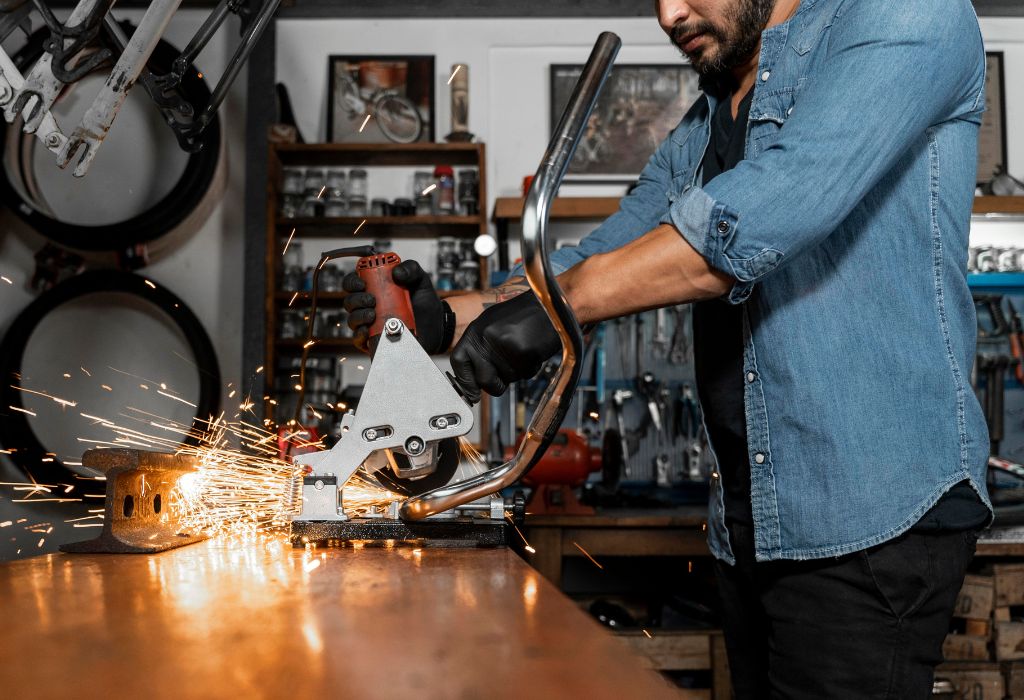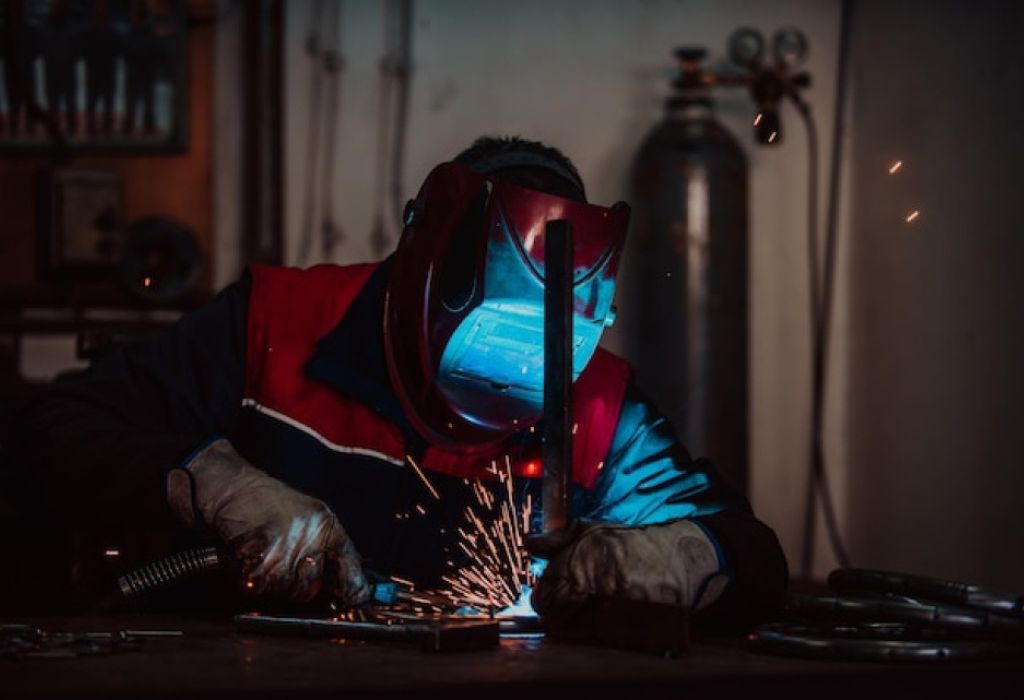In a busy fabrication shop, sparks fly as a welder fuses steel beams with precision and focus. Behind the protective helmet lies a skillset that keeps bridges standing, pipelines flowing, and ships sailing.
Curiosity often arises: what is a welder job beyond the striking arc and glowing metal. The answer reveals a craft that blends technical knowledge, physical skill, and strict safety practices.
The role of a welder stretches far beyond melting two pieces of metal together. It involves reading blueprints, preparing materials, selecting the right process, and ensuring every weld meets quality codes.
According to the U.S. Bureau of Labor Statistics, the median annual wage for welders, cutters, solderers, and brazers was $51,000 in May 2024 source. Employment is projected to grow 2% from 2024 to 2034, keeping steady demand across industries source.
These figures highlight both the importance and stability of welding as a profession. From pipelines in energy fields to aircraft in aerospace, welders remain essential wherever metal structures must hold under stress.
The benefit of pursuing this career goes beyond wages. Welders gain the satisfaction of seeing their work become part of the world’s infrastructure, knowing that precision and safety depend on every bead they lay.
This guide explores the responsibilities, skills, safety measures, and career opportunities that define welding. By the end, the question what is a welder job will be answered with clarity, showing how this role shapes industries and careers worldwide.
What a Welder Actually Does (Day-to-Day Scope)

A welder’s job involves much more than striking an arc. Daily tasks include preparing materials, following drawings, and applying the right process to create durable joints.
Welders also inspect their work, maintain tools, and ensure compliance with safety standards. The balance of precision and responsibility defines the profession.
What tasks define a welder’s shift?
Reading blueprints, setting up equipment, welding joints, and checking dimensions.
Who sets the welding parameters?
Parameters follow a Welding Procedure Specification (WPS) approved by engineers or supervisors.
How is quality verified?
Through visual inspection during welding and final checks by QC inspectors.
What about equipment maintenance?
Welders maintain their machines, cables, torches, and protective gear daily.
Do welders document their work?
Yes, many projects require logs for quality assurance and traceability.
Core Welding Processes You’ll Use
Welding is not a single method. Different processes are used depending on material, thickness, and project type.
The most common processes include SMAW (stick), GMAW/MIG, GTAW/TIG, and FCAW, with brazing and soldering used in lighter work.
Which process is most beginner-friendly?
MIG and flux-cored welding are easiest for learning and production speed.
Where does TIG fit?
TIG is used for precise, high-quality welds on thin stainless steel and aluminum.
When is stick welding used?
For outdoor and field jobs, as it tolerates dirty or rusty materials.
Is brazing considered welding?
No, it joins metals at lower temperatures without melting the base material.
Do welders learn all processes?
Most start with one, but multi-process skills increase employability.
Reading the Job: Blueprints, Symbols, and WPS
Welders must read technical drawings and weld symbols accurately. These symbols dictate joint design, size, and required processes.
The Welding Procedure Specification (WPS) provides the step-by-step plan welders must follow to meet project and code standards.
What is a WPS?
A document that defines approved methods, parameters, and materials for a weld.
Who qualifies the WPS?
Engineers and QC departments create WPSs based on procedure qualification tests (PQRs).
Do welders write WPSs?
No, but they follow them closely to maintain quality and compliance.
Why are weld symbols important?
They communicate all welding requirements directly from the blueprint.
How does following WPS affect safety?
It ensures welds meet strength and quality standards required by codes.
Safety and PPE: Non-Negotiables
Welding exposes workers to intense light, heat, fumes, and sparks. Safety practices and personal protective equipment (PPE) protect welders daily.
Proper helmets, gloves, leathers, and respirators are as essential as skill in maintaining safety.
Are fume controls required?
Yes, local ventilation or respirators must be used when fumes are present.
Which shade lens is needed?
Shade varies by process, but auto-darkening helmets adjust automatically.
Why is fire safety critical?
Welding sparks can ignite nearby flammable materials quickly.
Is hearing protection important?
Yes, cutting and grinding often produce high noise levels.
Do welders receive ongoing safety training?
Yes, new processes and job sites require regular refreshers.
Quality and Inspection: How Work Gets Accepted
Weld quality determines whether a project is safe and code-compliant. Welders self-check their work before final inspection.
Quality control teams use visual inspections and sometimes non-destructive testing (NDT) methods to verify integrity.
Who signs off on welds?
Authorized inspectors or QC departments approve work after testing.
Are small defects repairable?
Yes, approved repair procedures can correct minor discontinuities.
What is NDT?
Testing methods like ultrasonic, magnetic particle, or X-ray inspection.
Why is documentation needed?
It creates traceability for safety audits and warranty claims.
Do welders help inspectors?
Yes, welders often point out areas for review before sign-off.
Work Environments and Sectors

Welders work in fabrication shops, construction sites, shipyards, pipelines, and aerospace facilities. Each sector demands unique skills and conditions.
Some welders work indoors with controlled environments, while others perform field jobs in extreme weather.
Where do entry-level welders start?
Many begin in fabrication shops or production lines.
Is travel common?
Yes, especially for pipeline and shutdown work requiring temporary relocation.
Do unions affect the job?
Union positions often provide higher wages and stronger benefits.
Are night shifts common?
Yes, many industries operate 24/7, requiring multiple shifts.
Which sectors pay most?
Oil, gas, and aerospace projects typically offer higher pay.
Skills and Traits Employers Want
Technical skill is vital, but employers also value reliability, communication, and teamwork. Welders who balance skill with professionalism advance quickly.
Attention to detail, safety awareness, and adaptability separate top performers from average workers.
Top technical skill to master?
Producing repeatable, high-quality welds across different positions.
Do certifications replace experience?
No, both hands-on skill and credentials matter equally.
How do welders show quality?
Passing bend or break tests and keeping a portfolio of welds.
Is cross-training useful?
Yes, learning multiple processes makes welders more versatile.
What soft skills matter?
Time management, communication, and safety awareness are critical.
Training Paths and Credentials
Many welders enter the trade through vocational schools, apprenticeships, or on-the-job training. Credentials validate skills and open doors to higher-paying jobs.
The AWS Certified Welder program is widely recognized and tests performance to a specific WPS.
What is AWS Certified Welder?
A certification proving ability to weld to code standards under supervision.
Is school required?
No, but structured training accelerates skill development.
How long to become employable?
Some programs last a few months, while apprenticeships take years.
Do employers pay for tests?
Many cover exam and renewal fees to keep welders qualified.
Is ongoing education required?
Yes, codes and technology evolve, requiring continual learning.
Pay, Shifts, and Outlook
According to the Bureau of Labor Statistics, the median annual pay for welders was $51,000 in May 2024 source. The highest 10% earned more than $75,850, with pay varying by sector.
Employment is projected to grow 2% through 2034, with steady demand for infrastructure, manufacturing, and energy projects.
Is welding a good-paying trade?
Yes, especially with certifications and specialized skills.
Do welders work overtime?
Yes, shutdowns and construction projects often require extended shifts.
Where are the best-paying jobs?
Pipeline, aerospace, and refinery sectors offer top wages.
Does certification boost pay?
Yes, credentials often come with wage premiums.
Is demand stable?
Yes, infrastructure and energy ensure consistent opportunities.
Career Progression Beyond Welder
Welding offers clear career ladders into inspection, supervision, and specialized roles. Many welders become leaders or technical experts.
Advancing into quality control, NDT, or even welding engineering is possible with added training.
How to become an inspector?
Gain field hours, study codes, and pursue AWS CWI certification.
Is NDT a good option?
Yes, it increases demand and pay potential.
What leadership roles exist?
Lead welder, foreman, and supervisor are common paths.
Can welders move into robotics?
Yes, automation and robotic welding create new career routes.
Is teaching an option?
Experienced welders often become instructors in trade schools.
A Day in the Life (Shop vs Field)
Shop welders focus on repetitive production with controlled conditions. Field welders handle variable environments and complex setups.
Both roles require discipline, but field work often pays more due to travel and overtime.
Which path is better for beginners?
Shops provide consistency for building confidence.
Why does fieldwork pay more?
Travel, hazards, and unpredictable conditions raise wages.
Does weather matter?
Yes, outdoor welders face challenges like heat, cold, and wind.
Are per diem allowances offered?
Yes, traveling welders often receive daily stipends.
Do shop welders advance?
Yes, many move into specialized roles or supervisory positions.
Tools, Machines, and Materials

Welders use power sources, torches, wire feeders, grinders, clamps, and PPE daily. Materials range from carbon steel to stainless and aluminum.
Consumables like electrodes, filler wire, and shielding gas are vital to consistent quality.
Do welders choose machines?
Shops assign them, but welders adjust settings as needed.
How are fillers selected?
Based on WPS requirements and material compatibility.
Why are inverter machines popular?
They are lighter, more efficient, and provide stable arcs.
Are consumables expensive?
Yes, filler metals and shielding gases add significant cost.
Do tools affect weld quality?
Yes, well-maintained equipment produces consistent results.
How to Get Hired: Portfolio, Tests, and Interviews
Employers often test welders with plate or pipe welds before hiring. A strong portfolio improves chances.
Soft skills like punctuality, teamwork, and safety awareness are also evaluated.
What test should welders practice first?
Common entry tests include 3G plate or 6G pipe welds.
Do companies retest certified welders?
Yes, many require in-house performance tests.
Should resumes include processes?
Yes, list materials, positions, and processes mastered.
How important is punctuality?
Critical, as welding teams rely on strict schedules.
Is a portfolio necessary?
Yes, photos and test records showcase ability.
Conclusion
What is a welder job? It is a skilled trade combining technical knowledge, physical precision, and safety awareness to build the world’s infrastructure.
From blueprints to final inspections, welders ensure structures are strong, reliable, and code-compliant. With steady demand, solid pay, and career growth into inspection or leadership, welding offers stability and pride in craftsmanship.
For those ready to enter a hands-on trade, welding provides not only a job but a career that shapes industries and communities.

I’m Darrell Julian, the founder, lead writer, and hands-on welding enthusiast behind ArcWeldingPro.com. With more than 15 years of real-world welding experience, I created this platform to share what I’ve learned in the field, in the shop, and in the heat of the arc.


